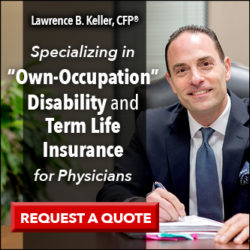 This is a guest post by Platinum Sponsor Lawrence Keller , CFP®, CLU®, ChFC®, RHU®, LUTCF that explores issues in a group disability insurance plan for physicians.
This is a guest post by Platinum Sponsor Lawrence Keller , CFP®, CLU®, ChFC®, RHU®, LUTCF that explores issues in a group disability insurance plan for physicians.
As you know, I am a board certified dermatologist. Unfortunately, like many medical specialty groups, mine offers a “discounted” disability insurance plan. I'm sure the American Academy of Dermatology does not purposely offer bad products for their members – I will just assume they are uninformed like many physicians.
I actually called the underwriting company to ask for their policy certificate and they would not send it to me until I actually purchased their plan. Lawrence explains why this group disability plan is flawed. In case you need a primer on disability insurance for physicians, read this.
The American Academy of Dermatology’s (AAD) Group Disability Income Insurance Plan: Caveat Emptor
As an insurance agent that specializes in disability insurance for physicians, I am often asked to review and comment on the AAD’s group disability income insurance policy. This policy which is available to all AAD members who meet the following criteria:
- They are in good standing who are under age 60,
- A resident of the United States or Puerto Rico,
- and actively working full-time (at least 30 hours per week).
Unfortunately, there are many potential problems/issues associated with this policy, as well as, similar offerings from other professional associations. This article will focus on the specifics of Plan 1 (there are two plans available), including a Residual Disability Benefit, which is underwritten by New York Life Insurance Company.
1. It is not Non-Cancelable and Guaranteed Renewable
“Insurance will end at the earliest of: the date the group policy ends, the date insurance ends for your class, the end of the period for which the last premium has been paid for you, the date you attain age 70, the date you cease to be actively at work full-time (30 or more hours) for reasons other than disability, the date you cease to be a member in good standing with AAD, or the day before you begin active duty in the armed forces.”
A policy that is Non-Cancelable and Guaranteed Renewable provides the greatest degree of protection to you as a consumer. Meaning, as long as required premiums are paid, the policy can’t be cancelled, premiums increased, or coverage terms changed until the policy expiration date (typically age 65).
2.The Premium Rates Are Not Guaranteed
“Premium rates are based on your actual age as of the effective date of your insurance; scheduled increases will occur as you enter each new age bracket (under age 30, 30-39, 40-49, 50-59, 60-64*, 65-69*)”.
3. It Does Not Have an “Own-Occupation” Definition of Total Disability
Total disability means during the waiting period and next 60 months, your complete inability to perform the material duties of your regular job. “Your regular job” is that which you were performing on the day before total disability began. After such 60 months, total disability means your complete inability to perform the material duties of any gainful job for which you are reasonably fit by training, education or experience”.
In any case, “To be considered totally disabled, you must also be under the regular care of a physician, and must not be performing the duties of any gainful job”.
At this time of this writing, depending upon your state of residence, there are only six companies that potentially offer this definition to physicians – Berkshire Life (a Guardian Company), Standard, MassMutual, Principal, Ameritas and Ohio National.
4. The Number of Days Required to Meet the Elimination Period Must be Consecutive
“The waiting period is only satisfied if you are not working in any occupation”. Individual policies do not require this and, for example, might specifically state that “You must be Disabled before benefits begin to accrue and starts on the first day that You are Disabled. The days within this period need not be consecutive but they must occur within the Accumulation Period. Benefits will not accrue or be payable during the Elimination Period”.
The waiting period is defined as the period of time from the start of total disability during which no benefits are payable. The Waiting Period is the number of consecutive days you must be Totally Disabled by a covered illness or accident before benefits begin. This is another aspect of a group disability insurance plan to explore fully.
5. You Must Be Totally Disabled Before You Can Collect Residual Disability Benefits
“If you become residually disabled within 31 days after a period of total disability for which monthly benefits are payable, the insurance company will pay residual benefits”.
In his article “What to Look for in Disability Income policies”, the late Peter C. Katt, CFP®, a fee-only insurance adviser located in West Bloomfield, Michigan, stated, “Do not buy a disability income policy that has a qualification period. There are too many diseases that are progressive and have no total disability at the beginning. Under such circumstances, a qualification period of, say, 30 days would prevent the insured from receiving any residual benefits.”
Ideally, your disability insurance policy should not require that you be totally disabled prior to collecting Residual Disability benefits. A good example of this might be a physician that has not been feeling great and, as a result, has been working sporadic hours. They have their good days and their bad days. Due to their symptoms, they have and continue to consult with various medical specialists in hope of getting a differential diagnosis.
This goes on for years and, as a result, they are working fewer days per week, fewer hours per day, seeing fewer patients and/or performing fewer procedures – causing a (potentially substantial) loss of income. Finally, they are diagnosed with Multiple Sclerosis and told they can no longer work in their medical specialty.
Only at this point, after the waiting period is satisfied and they meet the definition of total disability in the policy, can they potentially qualify for Residual benefits under the AAD’s policy.
6. There is No Recovery Benefit
While any policy you purchase must include a Residual or Partial Disability Rider, what happens if you have physically recovered and returned to work on a full-time basis but continue to experience a loss of income? A Recovery Benefit is designed to do more to assist with your financial recovery following a disability – especially if your practice has been built on referrals from existing patients and/or other physicians. Should you continue to suffer a loss of income of 15-20 percent or more, compared to your pre-disability income, and there’s a demonstrable relationship between your current loss of income and your prior disability, some companies will continue to pay benefits to the age of 65 or longer.
Other companies continue to pay for a limited period of time (typically 12, 24 or 36 months), which may or may not properly support your financial recovery. Therefore, if some or all of your compensation is tied to productivity, you should make certain that the policy you purchase contains a liberal recovery benefit.
7. Limitations Exist for Claims Related to Mental and Nervous Disorders
“Limited monthly benefits will be paid for disability due to alcoholism, drug addiction and mental, nervous or emotional disorders. If total disability is due to alcoholism, drug addiction or a mental, nervous or emotional disorder, the maximum payment period while such disability continues will be limited to 24 months”.
While some carriers will cover claims for mental and nervous conditions in the same way as other disabilities, the majority of companies limit these claims to a maximum of 24 months (either per period of disability or over your lifetime). This limitation is invoked if the primary cause of disability was solely a psychiatric or substance abuse disorder or diagnosis including, but not limited to, post-traumatic stress syndrome, anxiety, depression and or alcohol abuse/addiction.
Although many physicians will opt to purchase a policy with the least amount of restrictions, some willingly accept a policy with this limitation in order to take advantage of the cost savings associated with it.
8. There is No Cost Of Living Adjustment (COLA) Rider Available
A COLA Rider is designed to help your benefits keep pace with inflation after your disability has lasted for 12 months. This adjustment can be a flat percentage or tied to the Consumer Price Index. Although costly, this rider can provide significant increases to your monthly benefit if you are disabled early in your career.
9. There is No Increase Option Available
This rider is a must for young physicians. It allows you to apply for additional disability insurance coverage, regardless of your health, as your income rises.
Essentially, you’re paying for the right to increase your policy’s monthly benefit without undergoing another exam, blood test, urine test, or answering any medical questions. This guarantees that any medical conditions that develop after your original policy’s purchase would be fully covered, and not subject to new medical underwriting.
10. The Monthly Benefit May Not be Adequate
“You can choose monthly benefit amounts ranging from $500 to $10,000, in $100 increments. Total benefits you receive from this plan and from any other income replacement plans (including Worker’s Compensation, Social Security, employer-sponsored salary continuation, group or franchise plans or retirement programs) may not exceed 70% of your basic monthly pay. Basic Monthly Pay means the monthly rate of pay from your employer and does not include commissions, bonuses, overtime pay or other extra compensation”.
Individual disability insurance companies will typically issue policies with monthly benefits from $15,000-$20,000 month. However, by combining companies, you can potentially reach a total of up to $30,000 month of individual disability insurance coverage (or up to $35,000 month with group LTD coverage).
As a result, for high income specialties, I often combine two companies to allow them to potentially reach this higher amount, subject to their income and other disability insurance coverage inforce, if any.
11. You Are Not the Policyowner
“The group policy is issued to the American Academy of Dermatology under Group Policy No. G-30378-0/GMR-FACE. New York Life reserves the right to change rates on any premium due date and on any date which benefits are changed but it may only do so on a class-wide basis (a group of insureds with the same age, gender and/or waiting period). Changes to the group policy are subject to agreement between New York Life and the group policyholder.”
Although initially low in cost, association plans, such as the AAD’s Group Disability Income Insurance Plan, do not provide the customized benefits that can be achieved by purchasing a high-quality individual disability insurance policy.
In my opinion, this offering is best summed up by the old adage “you get what you pay for”. Keep in mind that many insurance companies make discounts available on individual disability insurance policies through hospital affiliation or professional associations. While this can provide male Dermatologists with a savings of 10%-20% off of their policies, female physicians can save as much as 60% off of the normal female rates if a gender neutral or “unisex” rate is available.
Agents that specialize in working with physicians should know of and have access to them. Otherwise, establishing one requires that 3-5 employees working for the same employer purchase policies from the same insurance company.
Ideally, you want to purchase your group disability insurance plan policy from an agent that represents several insurance carriers, provide you with illustrations of coverage from each and will review the differences between them with you in detail. You can then make a decision based upon the policy or policies that best meet your individual needs, goals, and budget.
Lawrence B. Keller, CFP®, CLU®, ChFC®, RHU®, LUTCF is the founder of Physician Financial Services, a New York- based firm specializing in income protection and wealth accumulation strategies for physicians. He can be reached at (516) 677-6211 or by email to [email protected] with comments or questions.
* For renewal purposes only. Coverage terminates at age 70.
The AAD group LTD plan is not available in Alaska, Deleware, Florida, Louisiana, Maine, Maryland, Missouri, Montana, New Hampshire, New Mexico, North Carolina, Nevada, Ohio, Oregon, South Dakota, Texas, Utah, Vermont, Virginia, Washington and Wyoming.
These are the personal views of the author and may not represent the views and opinions of The Guardian Life Insurance Company of America or its subsidiaries or affiliates thereof.
Registered Representative and Financial Advisor of Park Avenue Securities LLC (PAS), 355 Lexington Avenue, 9th Floor, New York, N Y 10017-6603, 212-541-8800. Securities products and advisory services are offered through PAS, 1-516-677-6200. Financial Representative, The Guardian Life Insurance Company of America, New York, NY (Guardian). PAS is an indirect wholly owned subsidiary of Guardian. Physician Financial Services is not an affiliate or subsidiary of PAS or Guardian.
PAS is a member FINRA, SIPC
2018-54235 Exp. 02/19
Do you have a group disability insurance plan? Make sure you understand the terms and limitations.

Get the bestselling book - Defining Wealth for Women.



